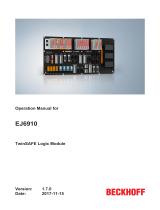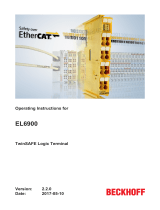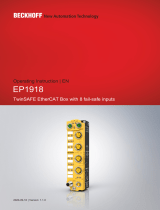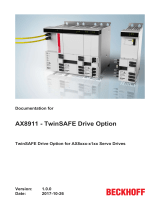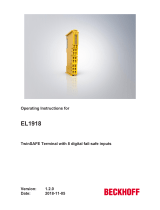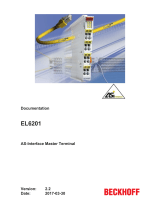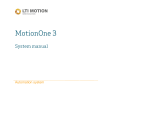Page is loading ...

Operation Manual for
EL6910
TwinSAFE Logic Terminal
1.8.0
2019-01-09
Version:
Date:


Table of contents
EL6910 3Version: 1.8.0
Table of contents
1 Foreword ....................................................................................................................................................5
1.1 Notes on the documentation..............................................................................................................5
1.2 Safety instructions .............................................................................................................................6
1.2.1 Delivery state ..................................................................................................................... 6
1.2.2 Operator's obligation to exercise diligence ........................................................................ 6
1.2.3 Description of safety symbols ............................................................................................ 7
1.3 Documentation issue status ..............................................................................................................8
1.4 Version history of the TwinSAFE product..........................................................................................9
1.5 References ......................................................................................................................................10
2 TwinSAFE System Description ..............................................................................................................11
2.1 Extension of the Beckhoff I/O system with safety functions ............................................................11
2.2 Safety concept.................................................................................................................................11
3 Product description.................................................................................................................................12
3.1 EL6910 - TwinSAFE logic terminal..................................................................................................12
3.2 Intended use....................................................................................................................................13
3.3 Technical data .................................................................................................................................15
3.4 Safety parameters ...........................................................................................................................16
3.5 Dimensions......................................................................................................................................17
4 Operation..................................................................................................................................................18
4.1 Environmental conditions ................................................................................................................18
4.2 Installation .......................................................................................................................................18
4.2.1 Safety instructions ........................................................................................................... 18
4.2.2 Transport / storage .......................................................................................................... 18
4.2.3 Mechanical installation..................................................................................................... 18
4.2.4 Electrical installation ........................................................................................................ 25
4.2.5 TwinSAFE reaction times ................................................................................................ 28
4.3 Operation in potentially explosive atmospheres (ATEX) .................................................................30
4.3.1 Special conditions............................................................................................................ 30
4.3.2 Identification..................................................................................................................... 30
4.3.3 Date code and serial number........................................................................................... 31
4.3.4 Further ATEX documentation .......................................................................................... 31
4.4 Configuration of the terminal in TwinCAT........................................................................................32
4.4.1 Configuration requirements ............................................................................................. 32
4.4.2 Adding an EtherCAT coupler .......................................................................................... 32
4.4.3 Adding an EtherCAT Terminal......................................................................................... 32
4.4.4 Adding an EL6910 ........................................................................................................... 32
4.4.5 Address settings on TwinSAFE terminals with 1023 possible addresses ....................... 34
4.4.6 Creating a safety project in TwinCAT3 ........................................................................... 35
4.4.7 Downloading the safety application ................................................................................. 63
4.4.8 Online Mode .................................................................................................................... 67
4.4.9 New features in TC3.1 Build 4022 ................................................................................... 70
4.5 Info Data ..........................................................................................................................................89
4.5.1 Info data for the connection ............................................................................................ 89

Table of contents
EL69104 Version: 1.8.0
4.5.2 Info data for function blocks............................................................................................. 91
4.5.3 Info data for the TwinSAFE group ................................................................................... 92
4.5.4 Info data for the device .................................................................................................... 93
4.6 Version history.................................................................................................................................93
4.7 User Administration .........................................................................................................................94
4.8 Backup/Restore ...............................................................................................................................97
4.9 Export/import of the safety project.................................................................................................100
4.10 Diag History tab .............................................................................................................................102
4.11 Configuration of the PROFIsafe slave ...........................................................................................103
4.11.1 Configuration of the slave connection in the PROFIsafe master software .................... 105
4.11.2 Configuration of the PROFINET device......................................................................... 106
4.11.3 Sample program for parameterizationIn the following sample program the parameter data
are received, stored in the PLC as persistent data, resent to the EL6910 whenever the
device starts up, and stored in CoE object 0x8005. ...................................................... 107
4.12 Configuration of the PROFIsafe master ........................................................................................109
4.12.1 Valid PROFIsafe configurations..................................................................................... 111
4.12.2 Invalid PROFIsafe configurations .................................................................................. 112
4.13 TwinSAFE SC configuration ..........................................................................................................113
4.14 Customizing / disabling TwinSAFE groups....................................................................................117
4.15 Saving the analog group inputs persistently..................................................................................120
4.16 Project design limits of EL6910/EJ6910 ........................................................................................121
4.17 Sync-Manager Configuration.........................................................................................................121
4.18 Diagnostics ....................................................................................................................................124
4.18.1 Diagnostic LEDs ............................................................................................................ 124
4.18.2 Status LEDs................................................................................................................... 125
4.18.3 Diagnostic objects.......................................................................................................... 126
4.18.4 Cycle time of the safety project...................................................................................... 127
4.19 Diagnosis History...........................................................................................................................127
4.20 Maintenance ..................................................................................................................................130
4.21 Service life .....................................................................................................................................131
4.22 Decommissioning ..........................................................................................................................131
4.23 Firmware update of TwinSAFE products.......................................................................................132
5 Appendix ................................................................................................................................................135
5.1 Support and Service ......................................................................................................................135
5.2 Certificates.....................................................................................................................................136
5.2.1 EN 81-20, EN 81-22 and EN 81-50 ............................................................................... 138

Foreword
EL6910 5Version: 1.8.0
1 Foreword
1.1 Notes on the documentation
Intended audience
This description is only intended for the use of trained specialists in control and automation engineering who
are familiar with the applicable national standards.
It is essential that the following notes and explanations are followed when installing and commissioning
these components.
The responsible staff must ensure that the application or use of the products described satisfy all the
requirements for safety, including all the relevant laws, regulations, guidelines and standards.
Origin of the document
This documentation was originally written in German. All other languages are derived from the German
original.
Currentness
Please check whether you are using the current and valid version of this document. The current version can
be downloaded from the Beckhoff homepage at http://www.beckhoff.com/english/download/twinsafe.htm.
In case of doubt, please contact Technical Support [}135].
Product features
Only the product features specified in the current user documentation are valid. Further information given on
the product pages of the Beckhoff homepage, in emails or in other publications is not authoritative.
Disclaimer
The documentation has been prepared with care. The products described are subject to cyclical revision. For
that reason the documentation is not in every case checked for consistency with performance data,
standards or other characteristics. We reserve the right to revise and change the documentation at any time
and without prior announcement. No claims for the modification of products that have already been supplied
may be made on the basis of the data, diagrams and descriptions in this documentation.
Trademarks
Beckhoff
®
, TwinCAT
®
, EtherCAT
®
, EtherCATP
®
, SafetyoverEtherCAT
®
, TwinSAFE
®
, XFC
®
and XTS
®
are
registered trademarks of and licensed by Beckhoff Automation GmbH.
Other designations used in this publication may be trademarks whose use by third parties for their own
purposes could violate the rights of the owners.
Patent Pending
The EtherCAT Technology is covered, including but not limited to the following patent applications and
patents: EP1590927, EP1789857, DE102004044764, DE102007017835 with corresponding applications or
registrations in various other countries.
The TwinCAT Technology is covered, including but not limited to the following patent applications and
patents: EP0851348, US6167425 with corresponding applications or registrations in various other countries.

Foreword
EL69106 Version: 1.8.0
EtherCAT
®
and Safety over EtherCAT
®
are registered trademarks and patented technologies, licensed by
Beckhoff Automation GmbH, Germany.
Copyright
© Beckhoff Automation GmbH & Co. KG, Germany.
The reproduction, distribution and utilization of this document as well as the communication of its contents to
others without express authorization are prohibited.
Offenders will be held liable for the payment of damages. All rights reserved in the event of the grant of a
patent, utility model or design.
Delivery conditions
In addition, the general delivery conditions of the company Beckhoff Automation GmbH & Co. KG apply.
1.2 Safety instructions
1.2.1 Delivery state
All the components are supplied in particular hardware and software configurations appropriate for the
application. Modifications to hardware or software configurations other than those described in the
documentation are not permitted, and nullify the liability of Beckhoff Automation GmbH & Co. KG.
1.2.2 Operator's obligation to exercise diligence
The operator must ensure that
• the TwinSAFE products are only used as intended (see chapter Product description);
• the TwinSAFE products are only operated in sound condition and in working order.
• the TwinSAFE products are operated only by suitably qualified and authorized personnel.
• the personnel is instructed regularly about relevant occupational safety and environmental protection
aspects, and is familiar with the operating instructions and in particular the safety instructions contained
herein.
• the operating instructions are in good condition and complete, and always available for reference at the
location where the TwinSAFE products are used.
• none of the safety and warning notes attached to the TwinSAFE products are removed, and all notes
remain legible.

Foreword
EL6910 7Version: 1.8.0
1.2.3 Description of safety symbols
In these operating instructions the following instructions are used.
These instructions must be read carefully and followed without fail!
DANGER
Serious risk of injury!
Failure to follow this safety instruction directly endangers the life and health of persons.
WARNING
Risk of injury!
Failure to follow this safety instruction endangers the life and health of persons.
CAUTION
Personal injuries!
Failure to follow this safety instruction can lead to injuries to persons.
NOTE
Damage to the environment/equipment or data loss
Failure to follow this instruction can lead to environmental damage, equipment damage or data loss.
Tip or pointer
This symbol indicates information that contributes to better understanding.

Foreword
EL69108 Version: 1.8.0
1.3 Documentation issue status
Version Comment
1.8.0 • Description Multiple Download added
• Note added to Project Settings
• Description of mounting rail installation updated
1.7.0 • Note added to Customizing
• Description of firmware update added
• Version history of the TwinSAFE product added
• Note EN81 updated
• Foreword updated
• Safety instructions adapted to IEC 82079-1.
1.6.0 • Description of the new features in TwinCAT 3.1 Build 4022 added
• Notes for the extension of certificates with EN 81-20, EN 81-22 and EN 81-50 added
• Notes on diagnostic history added
• Project planning limits updated
• Notes on the arrangement of TwinSAFE components added
• References and note for info data added
1.5.0 • Explanatory text and sequence chart added under Backup/Restore
• Explanatory text for input and output process image added
• Description added to Sync Manager configuration
• TwinSAFE SC description updated
1.4.1 • Technical data for permissible air pressure expanded
1.4.0 • User administration screenshots updated
• State and Diag of the TwinSAFE group updated
• Type examination certificate added
1.3.0 • Screenshots updated
• Certificate added
1.2.0 • Standards reference updated
• Safety parameters updated
1.1.0 • Description of diagnostic object 0xFEA0 expanded
1.0.0 • First released version
• Backup/Restore description expanded

Foreword
EL6910 9Version: 1.8.0
Version Comment
0.5.0 • Descriptions of external connections, properties of FB ports, parameterization of Alias Devices,
Variable Mapping and Customizing updated
0.4.0 • Description of the group sequence added
• Check Safe Addresses description added
0.3.0 • System description added
0.2.0 • Screenshots for TwinCAT release adapted
• Description of info data revised
• LED description added
0.1.0 • Migration and structural adaptation
0.0.7 • System description updated
0.0.6 • Online View extended
0.0.5 • TwinSAFE group description extended
0.0.4 • PROFIsafe master/slave description extended
0.0.3 • Customizing extended
0.0.2 • Creating network and group descriptions
0.0.1 • Creation of the document
1.4 Version history of the TwinSAFE product
This version history lists the software and hardware version numbers. A description of the changes
compared to the previous version is also given.
Updated hardware and software
TwinSAFE products are subject to a cyclical revision. We reserve the right to revise and change the
TwinSAFE products at any time and without prior notice.
No claims for changes to products already delivered can be asserted from these hardware and/or
software changes.
A description of how a firmware (software) update can be performed can be found in chapter Firmware
update of TwinSAFE products [}132].
Date Software ver-
sion
Hardware
version
Modifications
25.01.2017 01 00 First release
06.02.2017 02 00 • Time stamp of diag messages optimized
• Revision display implemented
03.08.2018 03 00 • Swapping of data bytes for PROFIsafe implemented
• Update of the CoE Online display
• Optimization in case of communication errors at low
temperatures
• FB Muting: After an FB error in Backwards mode, the FB
error can be acknowledged without restarting the TwinSAFE
group.
• An error acknowledgement is now required after a user has
logged into the logic without deleting the project.

Foreword
EL691010 Version: 1.8.0
1.5 References
No Version Title / description
[1] 3.1.0 or newer Documentation – TwinSAFE Logic FB
This document describes the safety-related function blocks that are
available in the TwinSAFE Logic and form the safety-related application.
[2] 1.8.0 or newer TwinSAFE Application Guide
The application guide provides the user with examples for the calculation of
safety parameters for safety functions according to the standards DIN EN
ISO 13849-1 and EN 62061 or EN 61508:2010 (if applicable), such as are
typically used on machines.

TwinSAFE System Description
EL6910 11Version: 1.8.0
2 TwinSAFE System Description
2.1 Extension of the Beckhoff I/O system with safety
functions
The TwinSAFE products from Beckhoff enable convenient expansion of the Beckhoff I/O system with safety
components, and integration of all the cabling for the safety circuit within the existing fieldbus cable. Safe
signals can be mixed with standard signals as required. The transfer of safety-related TwinSAFE telegrams
is handled by the standard controller. Maintenance is simplified significantly thanks to faster diagnosis and
simple replacement of components.
The following basic functionalities are included in the TwinSAFE components:
digital inputs (e.g. EL19xx, EP1908), digital outputs (e.g. EL29xx), drive components (e.g. AX5805) and logic
units (e.g. EL6900, EL6910). For a large number of applications, the complete safety sensor and actuator
technology can be wired on these components. The required logical link of the inputs and the outputs is
handled by the EL69xx. In addition to Boolean operations, the EL6910 now also enables analog operations.
2.2 Safety concept
TwinSAFE: Safety and I/O technology in one system
• Extension of the familiar Beckhoff I/O system with TwinSAFE components
• Safe and non-safe components can be combined as required
• Logical link of the I/Os in the EL69xx TwinSAFE logic terminal
• Suitable for applications up to SIL3 according to EN61508:2010 and Cat4, PLe according to
DINENISO13849-1:2016-06
• Safety-relevant networking of machines via bus systems
• In the event of an error, all TwinSAFE components always switch to the wattless and therefore safe
state
• No safety requirements for the higher-level standard TwinCAT system
Safety over EtherCAT protocol (FSoE)
• Transfer of safety-relevant data via any media (“genuine black channel”)
• TwinSAFE communication via fieldbus systems such as EtherCAT, Lightbus, PROFIBUS, PROFINET
or Ethernet
• IEC 61508:2010 SIL 3 compliant
• FSoE is IEC standard (IEC 61784-3-12) and ETG standard (ETG.5100)
Fail-safe principle (fail stop)
The basic rule for a safety system such as TwinSAFE is that failure of a part, a system component or the
overall system must never lead to a dangerous condition. The safe state is always the switched off and
wattless state.
CAUTION
Safe state
For all TwinSAFE components the safe state is always the switched-off, wattless state.

Product description
EL691012 Version: 1.8.0
3 Product description
3.1 EL6910 - TwinSAFE logic terminal
The TwinSAFE Logic terminal is the link unit between the TwinSAFE inputs and outputs.
The EL6910 meets the requirements of EN62061:2005/A2:2015 and EN61508:2010SIL3, EN81-20:2014,
EN81-22:2014, EN81-50:2014 and ENISO13849-1:2015 (Cat4,PLe).
Fig.1: EL6910 - TwinSAFE Logic terminal

Product description
EL6910 13Version: 1.8.0
3.2 Intended use
WARNING
Caution - Risk of injury!
TwinSAFE components may only be used for the purposes described below!
The TwinSAFE terminals expand the application range of Beckhoff Bus Terminal system with functions that
enable them to be used for machine safety applications. The TwinSAFE terminals are designed for machine
safety functions and directly associated industrial automation tasks. They are therefore only approved for
applications with a defined fail-safe state. This safe state is the wattless state. Fail-safety according to the
relevant standards is required.
The EL6910 TwinSAFE Logic terminal is suitable for operation at the
• Beckhoff Bus Couplers, EK1xxx series
• Beckhoff CXxxxx series Embedded PCs with E-bus connection
WARNING
System limits
The TÜV SÜD certificate applies to the EL6910, the function blocks available in it, the documentation and
the engineering tool. Approved engineering tools are TwinCAT 3.1, TwinSAFE Loader and CODESYS
Safety for EtherCAT Safety Module. Any deviations from these procedures or tools, particularly externally
generated xml files for TwinSAFE import or externally generated automatic project creation procedures, are
not covered by the certificate.
WARNING
Power supply from SELV/PELV power supply unit!
The TwinSAFE components must be supplied with 24V
DC
by an SELV/PELV power supply unit with an out-
put voltage limit U
max
of 36V
DC
. Failure to observe this can result in a loss of safety.
CAUTION
Follow the machinery directive!
The TwinSAFE components may only be used in machines as defined in the machinery directive.
CAUTION
Ensure traceability!
The buyer has to ensure the traceability of the device via the serial number.

Product description
EL691014 Version: 1.8.0
CAUTION
Note on approval according to EN 81-20, EN 81-22 and EN 81-50
• The TwinSAFE components may only be used in machines that have been designed and installed in ac-
cordance with the requirements of the EN60204-1 standard.
• Provide a surge filter for the supply voltage of the TwinSAFE components against overvoltages. (Reduc-
tion to overvoltage category II)
• EN81 requires that in the case of devices with internal temperature monitoring, a stop must be reached
in the event of an overtemperature. In this case, passengers must be able to disembark (see EN81-20
chapter 5.10.4.3, for example). To ensure this, application measures are necessary. The internal termi-
nal temperature of the TwinSAFE components can be read out by the user. There is a direct switch-off at
the maximum permissible temperature of the respective TwinSAFE component (see chapter Tempera-
ture measurement).
The user must select a temperature threshold below the maximum temperature such that a stop can be
reached in all cases before the maximum temperature is reached. Information on the optimum terminal
configuration can be found under Notes on the arrangement of TwinSAFE components and under Exam-
ple configuration for temperature measurement.
• For the use of the TwinSAFE components according to EN81-22 and EN81-50, the conditions de-
scribed in the manuals for achieving category4 according to ENISO13849-1:2015 must be observed.
• The use of TwinSAFE components is limited to indoor applications.
• Basic protection against direct contact must be provided, either by fulfilling protection class IP2X or by
installing the TwinSAFE components in a control cabinet which corresponds at least to protection class
IP54 according to EN60529.
• The ambient conditions regarding temperature, humidity, heat dissipation, EMC and vibrations, as speci-
fied in the operating instructions under technical data, must be observed.
• The operating conditions in potentially explosive atmospheres (ATEX) are specified in the operating in-
structions.
• The safe state (triggering) of the application must be the de-energized state. The safe state of the Twin-
SAFE components is always the de-energized, switched-off state, and this cannot be changed.
• The service life specified in the operating instructions must be observed.
• If the TwinSAFE component is operated outside the permissible temperature range, it changes to
"Global Shutdown" state.
• The TwinSAFE components must be installed in a control cabinet with protection class IP54 according to
EN60529, so that the requirement for contamination level3 according to EN60664-1 can be reduced to
level2.
• The TwinSAFE components must be supplied by a SELV/PELV power supply unit with a maximum volt-
age of U
max
<=36V
DC
.

Product description
EL6910 15Version: 1.8.0
3.3 Technical data
Product designation EL6910
Number of inputs 0
Number of outputs 0
Status display 4 diagnostic LEDs
Minimum/maximum cycle time approx. 1 ms / according the project size
Fault response time ≤ watchdog times
Watchdog time min. 2ms, max. 60000ms
Input process image Dynamic, according to the TwinSAFE configuration in TwinCAT3
Output process image Dynamic, according to the TwinSAFE configuration in TwinCAT3
Supply voltage (SELV/PELV) 24V
DC
(–15%/+20%)
Current consumption via E-bus approx. 160mA
Power dissipation of the terminal typically 1W
Dimensions (WxHxD) 12mmx100mmx68mm
Weight approx.50g
Permissible ambient temperature (operation)
-25°C to +55°C (see notes in section Sample configuration for
temperature measurement [}20])
Permissible ambient temperature (transport/storage) -40°C to +70°C
Permissible air humidity 5% to 95%, non-condensing
Permissible air pressure (operation/storage/transport) 750hPa to 1100hPa
(this corresponds to an altitude of approx. -690m to 2450m above
sea level, assuming an international standard atmosphere)
Climate category according to EN 60721-3-3 3K3
(the deviation from 3K3 is possible only with optimal environmental
conditions and also applies only to the technical data which are
specified differently in this documentation)
Permissible level of contamination according to EN60664-1
Contamination level 2 (note chapter Maintenance [}130])
Inadmissible operating conditions TwinSAFE Terminals must not be used under the following operat-
ing conditions:
• under the influence of ionizing radiation (exceeding the
natural background radiation)
• in corrosive environments
• in an environment that leads to unacceptable soiling of the
Bus Terminal
Vibration / shock resistance conforms to EN60068-2-6/ EN60068-2-27
EMC immunity/emission conforms to EN61000-6-2/ EN61000-6-4
Shocks 15g with pulse duration 11ms in all three axes
Protection class IP20
Permitted operating environment In the control cabinet or terminal box, with minimum protection
class IP54 according to IEC60529
correct installation position
see chapter Installation position and minimum distances [}19]
Approvals CE, cULus, TÜVSÜD

Product description
EL691016 Version: 1.8.0
3.4 Safety parameters
Characteristic numbers EL6910
Lifetime [a] 20
Proof test interval [a] not required
1)
PFH
D
1.79E-09
%SIL3 of PFH
D
1.79%
PFD
avg
2.54E-05
%SIL3 of PFD
avg
2.54%
MTTF
D
high
DC high
Performance level PLe
Category 4
HFT 1
Classification element
2)
Type B
1. Special proof tests are not required during the entire service life of the EL6910 EtherCAT Terminal.
2. Classification according to IEC61508-2:2010 (see chapters 7.4.4.1.2 and 7.4.4.1.3)
The EL6910 EtherCAT Terminal can be used for safety-related applications according to IEC62061 and
IEC61508:2010 up to SIL3 and ENISO13849-1:2015 up to PLe(Cat4).
Further information on calculating or estimating the MTTF
D
value from the PFH
D
value can be found in the
TwinSAFE Application Guide or in ENISO13849-1:2015, TableK.1.
In terms of safety-related parameters, the Safety-over-EtherCAT communication is already considered with
1% of SIL3 according to the protocol specification.

Product description
EL6910 17Version: 1.8.0
3.5 Dimensions
Fig.2: Dimensions of the EL6910
Width: 12 mm (side-by-side installation)
Height: 100 mm
Depth: 68 mm

Operation
EL691018 Version: 1.8.0
4 Operation
4.1 Environmental conditions
Please ensure that the TwinSAFE components are only transported, stored and operated under the specified
conditions (see technical data)!
WARNING
Risk of injury!
The TwinSAFE components must not be used under the following operating conditions.
• under the influence of ionizing radiation (that exceeds the level of the natural environmental radiation)
• in corrosive environments
• in an environment that leads to unacceptable soiling of the TwinSAFE component
NOTE
Electromagnetic compatibility
The TwinSAFE components comply with the current standards on electromagnetic compatibility with regard
to spurious radiation and immunity to interference in particular.
However, in cases where devices such as mobile phones, radio equipment, transmitters or high-frequency
systems that exceed the interference emissions limits specified in the standards are operated near Twin-
SAFE components, the function of the TwinSAFE components may be impaired.
4.2 Installation
4.2.1 Safety instructions
Before installing and commissioning the TwinSAFE components please read the safety instructions in the
foreword of this documentation.
4.2.2 Transport / storage
Use the original packaging in which the components were delivered for transporting and storing the
TwinSAFE components.
CAUTION
Note the specified environmental conditions
Please ensure that the digital TwinSAFE components are only transported and stored under the specified
environmental conditions (see technical data).
4.2.3 Mechanical installation
DANGER
Risk of injury!
Bring the bus system into a safe, de-energized state before starting installation, disassembly or wiring of
the devices!

Operation
EL6910 19Version: 1.8.0
4.2.3.1 Control cabinet / terminal box
The TwinSAFE terminals must be installed in a control cabinet or terminal box with IP54 protection class
according to IEC60529 as a minimum.
4.2.3.2 Installation position and minimum distances
For the prescribed installation position the mounting rail is installed horizontally and the mating surfaces of
the EL/KL terminals point toward the front (see illustration below). The terminals are ventilated from below,
which enables optimum cooling of the electronics through convection. The direction indication “down”
corresponds to the direction of positive acceleration due to gravity.
Fig.3: Installation position and minimum distances
In order to ensure optimum convection cooling, the distances to neighboring devices and to control cabinet
walls must not be smaller than those shown in the diagram.

Operation
EL691020 Version: 1.8.0
4.2.3.3 Sample configuration for temperature measurement
Fig.4: Sample configuration for temperature measurement
The sample configuration for the temperature measurement consists of an EK1100 EtherCAT coupler with
connected terminals that match the typical distribution of digital and analog signal types at a machine. On the
EL6910 a safety project is active, which reads safe inputs and enables all 4 safe outputs during the
measurement.
External heat sources / radiant heat / impaired convection
The maximum permissible ambient temperature of 55°C was checked with the above sample con-
figuration. Impaired convection, an unfavorable location near heat sources or an unfavorable config-
uration of the EtherCAT Terminals may result in overheating of the terminals.
The key parameter is always the maximum permitted internally measured temperature of 95°C,
above which the TwinSAFE terminals switch to safe state and report an error. The internal tempera-
ture can be read from the TwinSAFE components via CoE.
/


